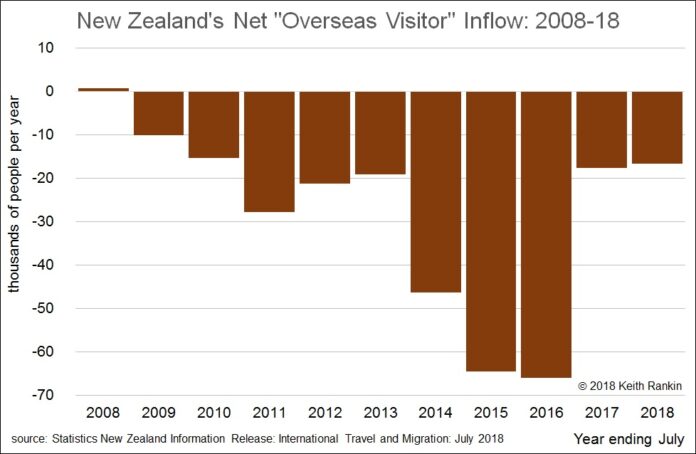Chart analysis by Keith Rankin.
According to the most recent ‘International Travel and Migration’ statistics, New Zealand has had a net outflow of 16,716 overseas visitors in the year ended July 1918. People leaving who arrived the year before, we might think. Not so.
From a decadal perspective, we should expect a small and increasing net annual inflow of overseas visitors, as we understand that tourism to New Zealand has generally been on the increase. (When tourism is showing a trend increase, there should be growing numbers of tourists who arrive in one year, and leave the following year.)
This month’s chart shows the actual recorded net inflow of overseas visitors. The numbers have been negative (ie a net outflow of visitors) for the entirety of the last 120 months. Indeed 304,859 more overseas visitors allegedly departed New Zealand than arrived in New Zealand over the past decade. We desperately need alternative facts. I do not believe that we clone and deport foreigners.
Some officially-published statistics are not damned lies; they are simply nonsense. Fortunately, Statistics New Zealand is now aware of this, and is embarking on an extensive program to collect more reliable data; data that does more than record ‘information’ on international departure and arrival cards. In the year to July 2016, net inflow of people into New Zealand peaked at 68,631. (It’s now down to 43,348.) Over the same period, as shown in the chart, net inflow of “overseas visitors” troughed at -66,081.
The commentariat barely noticed. What appears to have been happening is that, while large numbers of people travelling on overseas passports arrived with the intention of staying in New Zealand for at least a year, many left less than a year after they arrived. These were counted on the way in as immigrants, and then counted on the way out as visitors.
Additionally, there appears to be a significant floating population of people who move with relative ease in and out of New Zealand. Our arrival and departure statistics do not allow for these semi-attached ‘floaters’, for want of a better name to give them. (These people – as speculators and multiple property-owners – are likely to have had somewhat more influence on house prices than have genuine immigrants.)
Our demographers need to be following recent trends much more closely; twentieth century data classifications do not help us to understand human movement in the twenty-first century. Issues around immigration drive much of our public policy.
It is crucial to have accurate and well-nuanced demographic statistics; statistics that include migrant and tourism flows within New Zealand as well as flows without New Zealand.
We continue to blame immigration for both low wages and absurdly high house prices. In all that time, we have been counting many of our overseas visitors (especially students and guest-workers) as immigrants.
Additionally, many of our immigrants appear to have been so disappointed with their kiwi experience, that they chose to shuffle off too soon to be classified as permanent residents. The good news is that there are now many fewer immigrants flying out within 12 months of their arrival than there were from 2014 to 2016.








